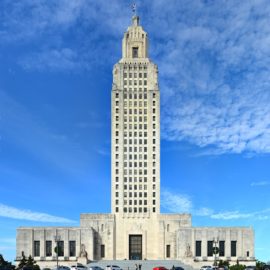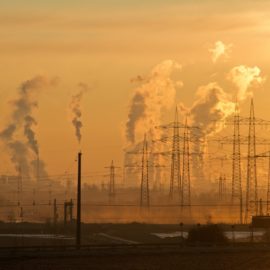
Louisiana’s carbon emissions are not equally spread as one sliver of the state emits most of them. Not surprisingly it is the area of Cancer Alley.
The heavily industrialized stretch of the Mississippi River extending from Baton Rouge to south of New Orleans accounts for more than half of the state’s greenhouse gas footprint some years, according to a new analysis. The paper, still undergoing peer review, found that, in any given year, the small sliver of Louisiana produces anywhere from 26% to 55% of the state’s disproportionately large amount of greenhouse gas emissions for nearly 50 years. Louisiana Universities Marine Consortium coastal scientist Alex Kolker, who led the research, said the region stood out as he began to dig into international data compiled on climate and air pollution. Emissions data mapped across the Gulf Coast region reflects how much carbon dioxide or sulfur dioxide is released with a 40 square mile area. Red areas reflect areas with the highest emissions, while dark blue is on the lowest end of the spectrum. Lines running across the map can reflect transportation routes from major ship channels in the water to interstates on land. In Louisiana, major hotspots for both greenhouse gas emissions and air pollutants fall along the Mississippi River from Baton Rouge down to south of New Orleans and the Lake Charles region in southwest Louisiana. The pattern of both types of emissions follow industrial development in the state.
wwno.org

Data from Emissions Database for Global Atmospheric Research (EDGAR)
Kolker has been in a position where the data becomes obvious.
Over the past two years, Kolker has sat on the scientific committee advising a state task force formed to guide Louisiana’s response to ever-growing threats of climate change.
Over the past two years, Kolker has sat on the scientific committee advising a state task force formed to guide Louisiana’s response to ever-growing threats of climate change. A greenhouse gas inventory, crafted by Louisiana State University’s Center for Energy Studies in 2021 for Gov. John Bel Edwards’ Climate Task Force, found that in 2018 the industrial sector accounted for about two-thirds of the state’s emissions. As discussions about the state’s carbon footprint progressed, he wanted to nail down the answer to one question: where are these planet-warming emissions coming from? Turns out, much of it is concentrated in one place — the same area notorious for its toxic air pollution and its long-debated health concerns. “I wanted to be able to put some numbers on it and start to quantify this,” Kolker said. “To say that, yes, this is a region with a lot of greenhouse gas emissions. Yes, this is the region with a lot of air pollutant emissions.”

Five percent of the land produces close to 50% of the emissions.
Though the swath of land accounts for less than 5% of the state’s area, the region — littered with petrochemical plants and other heavy industry — accounted for 45% to 55% of Louisiana’s annual carbon emissions over the last 48 years, according to the paper. The Lake Charles region was the second-biggest source of emissions. Kolker’s analysis mapped the state’s hotspots using a comprehensive, European dataset called the Emissions Database for Global Atmospheric Research (EDGAR) and sought to overlay the region’s patterns of air pollution, race and income. Not only did the region have a high concentration of greenhouse gas emissions, but those same sources produced a large amount of toxic air pollution as well. From 1970 to 2015, the region accounted for nearly half of the state’s particulate matter or nitrogen oxide emissions, according to the paper. And though Louisiana has seen a significant decline in total sulfur oxide emissions, the area was still responsible for 26% to 55% of the state’s overall emissions of the pollutant. That means the residents living there deal with more pollution than the majority of the state. “This study helps suggest that if you reduce greenhouse gas emissions, you can also reduce air pollution at the same time,” Kolker said. Actions taken to cut greenhouse gas emissions could lower air pollution and “lead to fewer adverse health impacts.” The study comes as the environmental justice movement, which sets out to address the uneven exposure of environmental hazards among racial minorities and low-income communities, has gained national prominence, though the crusade has deep roots in the region dating back decades.
Ideally the researcher needs to delve into the neighborhood but Kolker could only get to the parish level.
In Louisiana, figuring out who is most exposed to air pollutants is best examined at the neighborhood or census tract level near plants, but Kolker said the international dataset didn’t allow him to zoom in closer than the parish level. “What we said is a lot of these places where we see high greenhouse gas emissions or a lot of air pollution are places with large Black communities, places like the River Parishes,” he said. Because the study is still in peer review for the PLOS Climate journal, WWNO asked other scientists specializing in researching and mapping air pollution to review the paper and its findings. Both professors Slawomir Lomnicki of LSU and Julian Marshall of the University of Washington said the paper was grounded in sound data. Lomnicki, who has worked with the Louisiana Environmental Action Network on air pollution issues in the chemical corridor, said Kolker’s conclusions aligned with the level of industry in the area, though the amount of emissions coming from the area was significant.
Not all producers of toxic air also produce greenhouse gasses.
Lomnicki, who has worked with the Louisiana Environmental Action Network on air pollution issues in the chemical corridor, said Kolker’s conclusions aligned with the level of industry in the area, though the amount of emissions coming from the area was significant. “The climate warming is not concentrated in one specific area, so the consequences for minority and impoverished people are completely different,” he said. While toxic air pollutants can directly affect those living in the immediate vicinity, greenhouse gases have a global impact. International climate reports suggest Black, Brown, Indigenous and low-income communities, which are the same groups disproportionately affected by environmental pollution, will be most vulnerable to broader changes brought by global warming — from extreme heat and more intense hurricanes to water scarcity or high electricity costs, Lomnicki said. Expected to be published in PLOS Climate journal, Kolker is still incorporating feedback from the paper’s first round of academic peer review, where reviewers also approved of the data used but asked for more statistical analysis to better understand the relationship between the region’s emissions and its demographics. In its current form, the study is still subject to change before publication.
I have to admit that this story did not change my mind!



